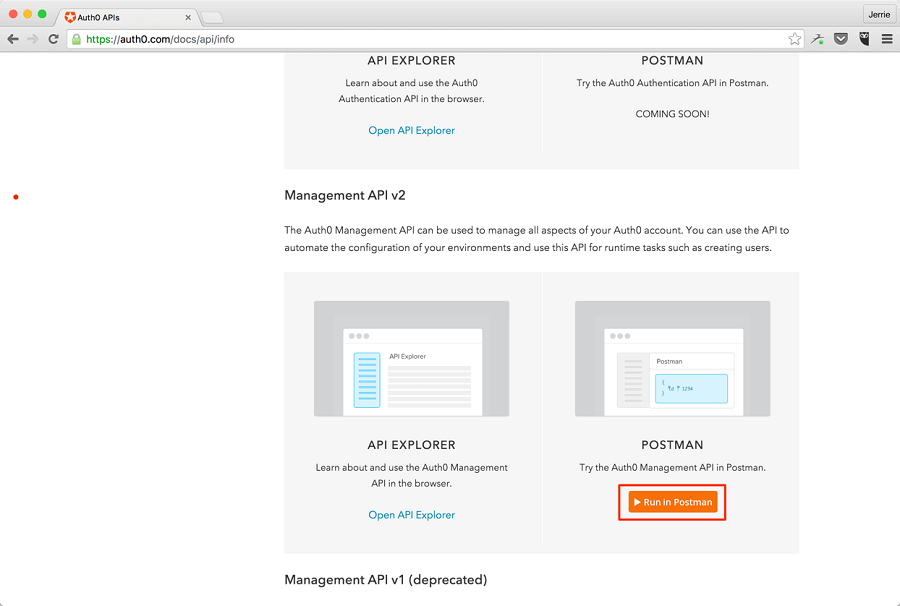

Course Collections Are You an Instructor Best Courses & Tutorials. Postman: We'll use this to try out the changes to our REST API in this chapter. Easily Add Authentication To Your APIs And. Auth0 with our ASP.NET backend Protecting endpoints Using the. (opens new window) Advanced Server Access. Build Secure APIs with Auth0 and Postman. "accept": "text/html,application/xhtml+xml,application/xml q=0.9,image/avif,image/webp,image/apng,*/* q=0.8,application/signed-exchange v=b3 q=0. Import any Okta API collection for Postman from the following list: Collections. Is this a bug or am I misusing the helper ? When checking the logs, I can see that the first authent GET does not include the audience as parameter. However, when I use the collection authentication helper in Postman, the JWT access token I get has an empty payload. …which gives me conform acces & ID JWT tokens. header 'content-type: application/x-www-form-urlencoded' \
#Auth0 postman collection code
I am able to get Access & ID tokens manually with a GET in browser : …get the code and re-inject it in the POST request : ❯ curl -request POST \ I’d like to experiment with Postman and to set up authentication at the Collection level using the Authorization Code flow. You can also use it to confirm that the pre-request script runs before each of your individual tests in your collection.I’m implementing Oauth2.0 authentication for minIO (open-source clone of AWS S3) with auth0 as OIDC provider. In the bottom-left corner is a console from which you can view all the logs you’ve written. You can also click Edit and change the contents.

If you click it you can see the current state of all your variables. In order to get an access token to call your own API through Postman you would have to fill the information requested in that dialog and do a couple of additional steps in your Auth0 Dashboard. In Postman, go to Authorization and select OAuth 2.0 as Type Press button Get. In the top right-hand corner there is an eye icon. For other OAuth clients, please refer to the corresponding product documentation. You’re done! But wait there’s more - Console and View the variables
#Auth0 postman collection manual
I thought I would share a write up I did to help you get past the manual process and have your tokens renewing automatically. I’m not crazy about that but Postman doesn’t have a solution for secrets management. Hey everyone, I have seen on a number of forums and stack overflow articles people expressing their frustration with the manual process Postman has for renewing OAuth2 tokens when they expire. I did put all my secrets in this script.I put some console.log statements as Postman has a console and logging is always a good thing.If there is a token AND it’s valid (it’s only good for 24 hours) then do nothing.If both variables are set but the expiry date is in the past I get a fresh token.If the token or expiry date is missing I get a fresh token and set the value This workspace is meant to do the work of defining and evolving OpenAPI and collections for documenting, mocking, testing, and integrating with Auth0 APIs.I went into Pre-request Scripts and wrote a script that does one of three things: Let’s jump straight into the Variables tab and create our two variables which I’ve called currentAccessToken and accessTokenExpiry.Clicked the three dots to open the menu.I’m choosing to create my variables relative to the collection. Checkout this article about scope in Postman. They can be anywhere from a global (across any test you’ve got) to the individual test. You need to think about the scope of the variables. I just want my requests to always use a valid bearer token! As you can imagine, this isn’t effective. To date I’ve been manually entering that token whenever I wanted to use an API endpoint. I have a Postman request to Auth0 to request a token. As I write each endpoint in my API I’m writing a Postman request so I can test it. Pretty much every endpoint in my API requires authentication. The following is a Javascript pre-request I’ve used to automate the process. I love using Postman but it is a pain having to remember to enter a valid Bearer Token.


 0 kommentar(er)
0 kommentar(er)
